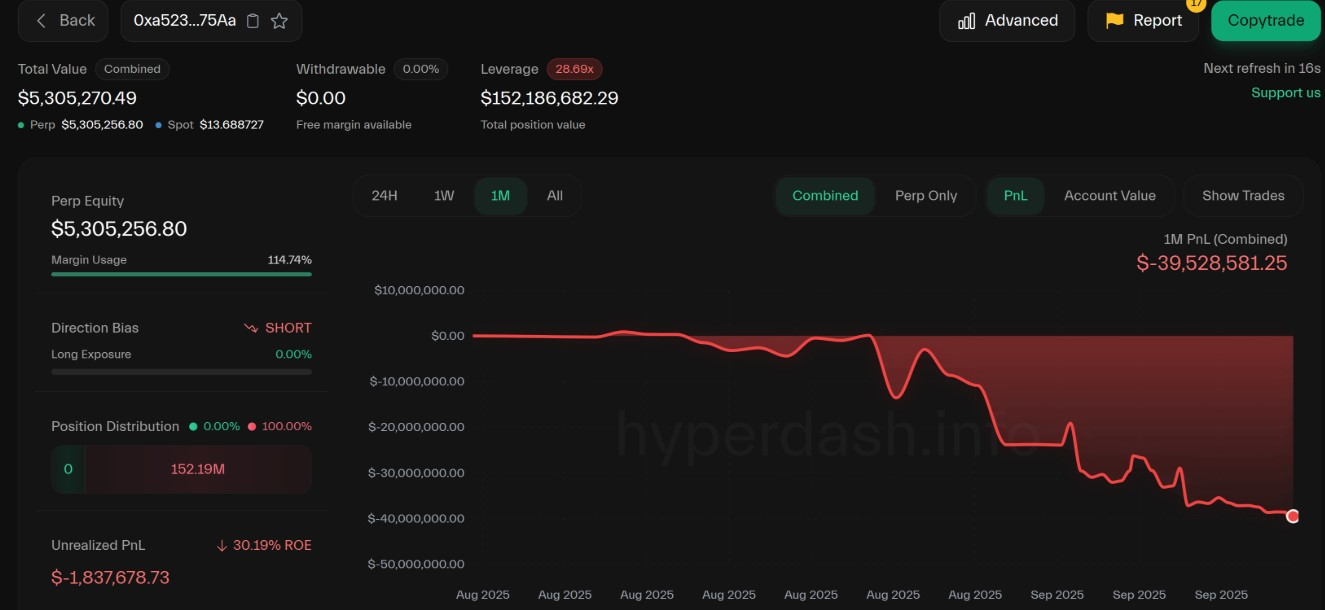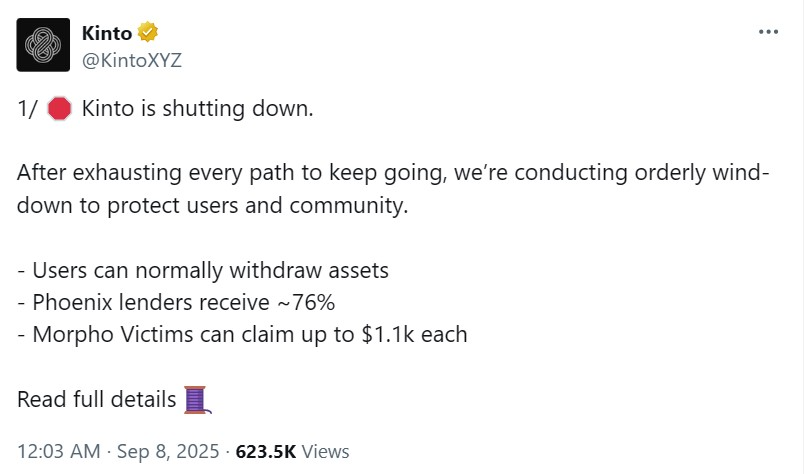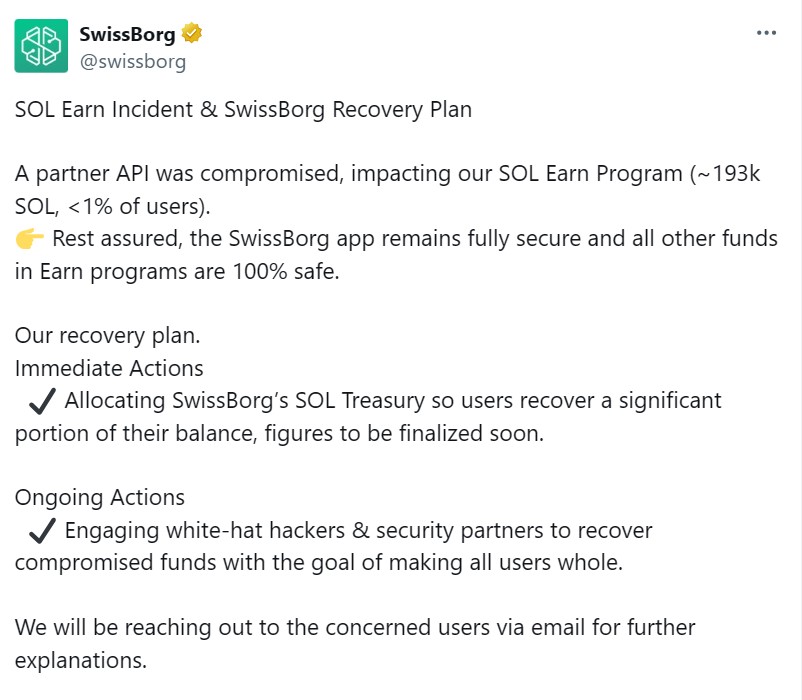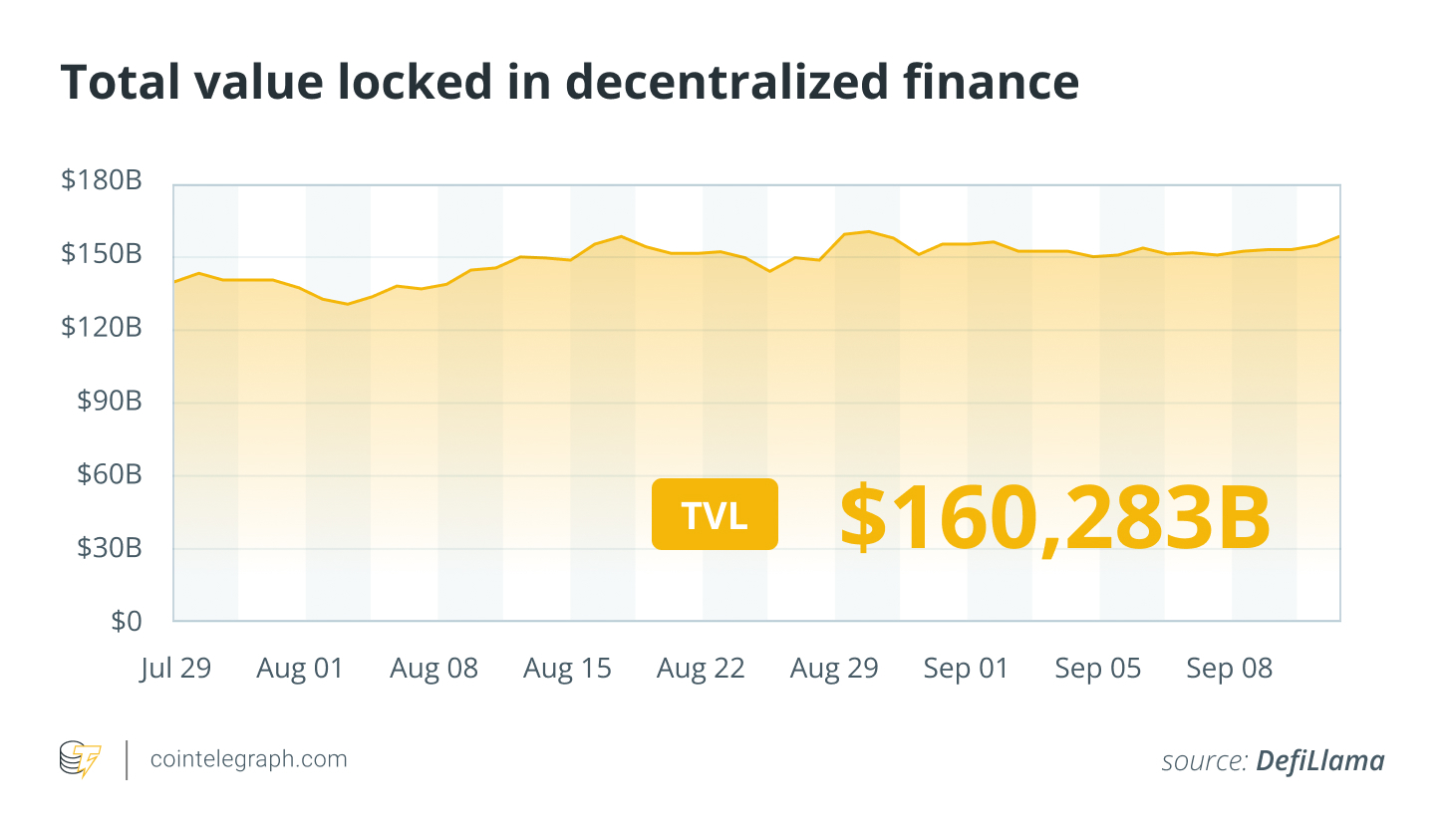MYX Finance Posts 1,100% Weekly Gain, May Be Linked to Alleged $170M Airdrop Sybil Attack and Whale Losses
HYPE
HYPE/USDT
$232,977,761.06
$25.42 / $24.17
Change: $1.25 (5.17%)
+0.0056%
Longs pay
Contents
Hyperliquid whale losses surged after heavy leveraged positions across multiple tokens, with on-chain data showing over $40 million lost on HYPE and an additional $35 million on ETH within a month. Key failures and exploits in DeFi projects amplified weekly volatility across tokens such as MYX, WLD and SOL.
-
Major on-chain losses: $40M+ lost on Hyperliquid HYPE trades
-
The Kinto Network token plunged 81% after its L2 announced a shutdown following a $1.6M hack
-
Bubblemaps flagged a 100-wallet Sybil claiming $170M in MYX airdrop tokens
Hyperliquid whale losses dominated headlines after $40M losses on leveraged trades; read how DeFi hacks and airdrop Sybils amplified market risk — stay informed.
MYX Finance’s native token was the week’s largest gainer with an over 1,100% rise; Worldcoin followed with more than 90% gains.
An unknown Hyperliquid trader has become the platform’s largest losing whale this month, exceeding $40 million in losses, according to on-chain trackers Lookonchain and Hyperdash (plain text sources). The wallet took heavy, high-leverage positions, liquidated HYPE and ETH trades, and still holds a leveraged position nearing $152 million.
Lookonchain reported the wallet sold roughly 900,000 HYPE tokens before the token rebounded, resulting in nearly $40 million in realized losses on Hyperliquid. The same trader later incurred roughly $35 million in losses on an Ether position, then an additional $614,000 on a short — with Bitcoin positions showing almost $2 million unrealized losses.

Whale loses $40 million in a month. Source: Hyperdash
What were the Hyperliquid whale losses and how did they occur?
Hyperliquid whale losses stemmed from high-leverage trades and rapid position entries and exits. On-chain data shows nearly $40M lost on HYPE after pre-rebound sells, plus ~$35M on ETH; the wallet still carries a 29x-levered $152M position, increasing liquidation risk.
How did leverage and market moves amplify losses?
The trader used near-30x leverage, which magnified price moves. Short-term volatility and rapid rebounds on HYPE and ETH triggered liquidations and margin events. Hyperdash on-chain analytics record $39.5M lost in the last 30 days for the same wallet (plain text source).
Why did Kinto Network shut down its L2 and why did the token crash?
The Kinto token plunged over 80% after Kinto Network announced its Ethereum layer-2 will wind down in September. The protocol cited worsening market conditions and failed fundraising attempts as decisive factors.
Kinto reported operating without salaries since July and a prior $1.6 million exploit tied to an ERC-1967 Proxy vulnerability. Community members noted unsustainably high stablecoin yields (historically advertised up to 130% APY) likely strained reserves after the hack.

Source: Kinto
What happened in the SwissBorg Solana exploit?
SwissBorg reported approximately 193,000 SOL (~$41M) stolen from its Earn program after a third-party staking partner API (Kilin) was compromised. The company said the core app and other Earn products were not impacted and assured users operations remain stable.
SwissBorg CEO Cyrus Fazel stated that while the amount is significant, it does not threaten the platform’s solvency and affected users will be contacted directly (plain text source).

Source: Swissborg
How is MegaETH funding sequencer fees with a yield-bearing stablecoin?
MegaETH announced the USDm yield-bearing stablecoin to channel reserve yield into sequencer fee offsets. The stablecoin is being developed with Ethena infrastructure and will route reserves into BUIDL, a tokenized US Treasury bill vehicle managed by BlackRock (plain text notes).
MegaETH co-founder Shuyao Kong said the yield model aims to lower user fees and enable more expressive application design on the layer-2.
What did Bubblemaps allege about the MYX airdrop?
Blockchain analytics firm Bubblemaps identified what it calls the largest Sybil airdrop attack in crypto history: 100 funded wallets claiming roughly $170M in MYX tokens. The wallets received similar BNB inflows from OKX minutes apart and had minimal prior activity, suggesting coordinated claims.
In this case, Bubblemaps highlighted simultaneous claiming patterns and uniform funding behaviors as evidence pointing to an organized Sybil operation (plain text source).
DeFi market overview — which tokens moved most this week?
According to market trackers Cointelegraph Markets Pro and TradingView (plain text mentions), MYX Finance led weekly gains with ~1,100% over seven days. Worldcoin (WLD) recorded over 90% gains. Most of the top 100 tokens ended the week in green, reflecting an episodic rotation into risk assets.

Total value locked in DeFi. Source: DefiLlama
Frequently Asked Questions
How much did the Hyperliquid whale lose in total?
On-chain trackers report roughly $40M lost on HYPE and about $35M on ETH within the last month, with additional smaller losses and nearly $2M unrealized on BTC positions — total realized and unrealized losses exceed $77M.
Can a leveraged whale recover from such losses?
Recovery depends on remaining capital, margin requirements and market direction. With a 29x leveraged $152M position still open, the wallet remains highly exposed; further adverse moves could trigger full liquidation.
What should users learn from the SwissBorg and Kinto incidents?
Central lessons: third-party integrations can introduce systemic risk, unusually high yields may signal unsustainable models, and diversified custodial practices and audits reduce single-point failures.
Key Takeaways
- Hyperliquid whale losses: High leverage caused >$40M realized losses on HYPE and major ETH losses.
- Kinto shutdown: L2 closure followed a $1.6M hack and failed fundraising; token dropped ~81%.
- Protocol risk: Third-party API vulnerabilities and airdrop Sybils highlight ongoing DeFi operational risks.
Conclusion
This week’s DeFi headlines underscore how leverage, security lapses and coordinated airdrop claims can rapidly reshape markets. Hyperliquid whale losses, Kinto’s shutdown and the SwissBorg SOL exploit together highlight operational and market risks for traders and protocols alike. Monitor on-chain data and project disclosures; stay cautious and diversified.
Thanks for reading our summary of this week’s most impactful DeFi developments. Join us next Friday for more stories, insights and education regarding this dynamically advancing space.
Comments
Yorumlar
Other Articles
Bitcoin Price Analysis: Will the Uptrend Continue?
1/11/2026
Ethereum 2.0 Update: How Will It Affect the Crypto Market?
1/10/2026
The Coming of Altcoin Season: Which Coins Will Stand Out?
1/9/2026
DeFi Protocols and Yield Farming Strategies
1/8/2026

